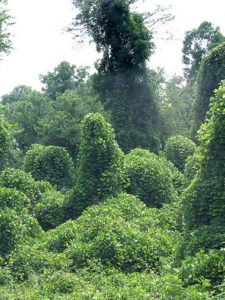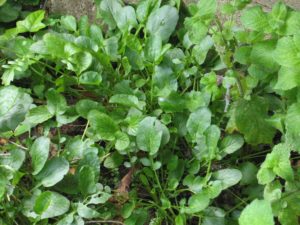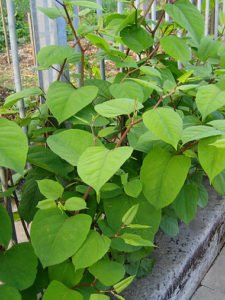
Kudzu is used to make jams and jellies and you can pickle the flowers that appear in August and September. Try steaming or boiling the roots until they’re tender and adding soy sauce or miso, as is often done in Asian cooking. The plant is used in Chinese medicine for treating allergies, colds, fevers and as a digestive aid. Brew a kudzu tea by chopping up a cup of leaves and boiling them for about 30 minutes.
 Red Clover has been used for ages as a folk remedy for cancer. It contains the phytoestrogen genistein, which has been found to have a protective effect against colon and prostate cancers. There is some evidence that phytoestrogens can have the opposite effect on breast cancer. Sprinkle red clover flowers over rice or cooked in soy sauce. In addition to being potential cancer-fighters, clover flowers are high in protein. You can eat white clover, but it’s not as nutritious or flavorful.
Red Clover has been used for ages as a folk remedy for cancer. It contains the phytoestrogen genistein, which has been found to have a protective effect against colon and prostate cancers. There is some evidence that phytoestrogens can have the opposite effect on breast cancer. Sprinkle red clover flowers over rice or cooked in soy sauce. In addition to being potential cancer-fighters, clover flowers are high in protein. You can eat white clover, but it’s not as nutritious or flavorful.

Watercress is an antioxidant powerhouse. It grows alongside streams and riverbanks in nearly every U.S. state. The most popular way to eat watercress is to add it to salads raw.
 Lamb’s Quarters is a weed commonly referred to as “wild spinach,” and it starts to appear in early summer after the last of the spring spinach has disappeared from farmer’s markets. It’s loaded with calcium and protein, as well as vitamins A, C and K, even more so than spinach. Wash them well, sauté them in olive oil while they’re still wet and add a dash of salt, garlic, pepper and a squeeze of lemon or lime.
Lamb’s Quarters is a weed commonly referred to as “wild spinach,” and it starts to appear in early summer after the last of the spring spinach has disappeared from farmer’s markets. It’s loaded with calcium and protein, as well as vitamins A, C and K, even more so than spinach. Wash them well, sauté them in olive oil while they’re still wet and add a dash of salt, garlic, pepper and a squeeze of lemon or lime.
 Japanese Knotweed looks a little bit like bamboo, but they’re not related—even though it’s sometimes called “Japanese Bamboo.” Harvest the green and red shoots when the weeds are 6 to 8 inches tall, before they turn woody. Remove any tough leaves or rind and steam or simmer for a tart, rhubarb-like taste.
Japanese Knotweed looks a little bit like bamboo, but they’re not related—even though it’s sometimes called “Japanese Bamboo.” Harvest the green and red shoots when the weeds are 6 to 8 inches tall, before they turn woody. Remove any tough leaves or rind and steam or simmer for a tart, rhubarb-like taste.
 Bamboo is actually a type of grass. Bamboo shoots are full of fiber, and are described as tasting like corn. Harvest shoots that are less than two weeks old and under 1 foot tall. Bamboo shoots have to be cooked before you eat them: Peel the outer leaves away and remove any tough flesh. Cut across the grain into one-eighth-inch slices, and boil in an uncovered pan for 20 minutes ( longer, if there’s still a bitter taste to them). Eat them with some soy sauce, add to salads, or use them in stir-fries.
Bamboo is actually a type of grass. Bamboo shoots are full of fiber, and are described as tasting like corn. Harvest shoots that are less than two weeks old and under 1 foot tall. Bamboo shoots have to be cooked before you eat them: Peel the outer leaves away and remove any tough flesh. Cut across the grain into one-eighth-inch slices, and boil in an uncovered pan for 20 minutes ( longer, if there’s still a bitter taste to them). Eat them with some soy sauce, add to salads, or use them in stir-fries.

Purslane has rounded, succulent, leaves and a reddish stem and grows everywhere. It’s loaded with antioxidant vitamins like vitamins A and C, and also contains healthy omega-3 fatty acids. You can eat the stems and leaves fresh—try them in salads or sandwiches—or use them in soups or in recipes that call for spinach.
 Dandelion greens have a slightly bitter taste when they mature, so harvest the tender leaves that appear in early spring and late fall, when they’re sweetest. The flowers are edible too and have a mildly bittersweet flavor. Dandelions have more beta-carotene than carrots.
Dandelion greens have a slightly bitter taste when they mature, so harvest the tender leaves that appear in early spring and late fall, when they’re sweetest. The flowers are edible too and have a mildly bittersweet flavor. Dandelions have more beta-carotene than carrots.
